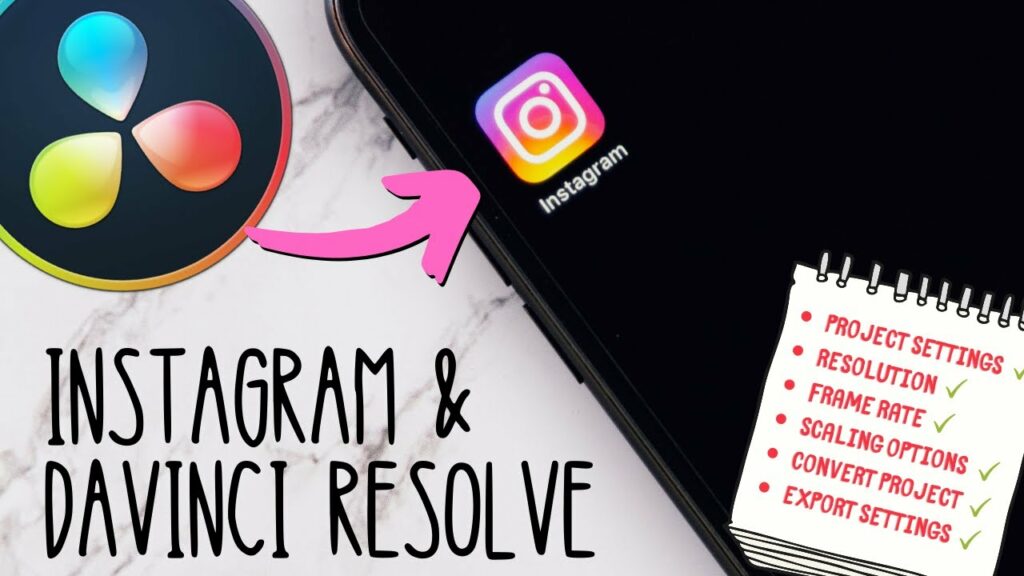Crafting the Perfect Instagram Render: A Comprehensive Guide to Rendering Projects for Instagram in DaVinci Resolve

Introduction:
Rendering projects for Instagram is an essential aspect of the video production process, allowing creators to share their content with a global audience on one of the most popular social media platforms. DaVinci Resolve, a leading editing software renowned for its robust feature set, offers editors a wide array of tools and workflows for rendering projects optimized for Instagram. However, understanding the intricacies of Instagram’s video requirements and configuring render settings accordingly can be challenging. In this comprehensive guide, we’ll explore the nuances of rendering projects for Instagram in DaVinci Resolve, empowering creators to deliver high-quality content that captivates and engages audiences on the platform.
Understanding Instagram Video Requirements:
Before delving into the specifics of rendering projects for Instagram in DaVinci Resolve, it’s crucial to understand Instagram’s video requirements and specifications.
- Aspect Ratio:
- Instagram supports various aspect ratios for video uploads, including 1:1 (square), 4:5 (portrait), and 16:9 (landscape). The aspect ratio you choose depends on the type of content you’re sharing and the platform’s current layout preferences.
- Resolution:
- Instagram recommends specific resolutions for optimal video quality and compatibility. For square and landscape videos, the recommended resolution is 1080×1080 pixels or higher. For portrait videos, the recommended resolution is 1080×1350 pixels or higher.
- Frame Rate:
- Instagram accepts a range of frame rates for video uploads, including 24fps, 30fps, and 60fps. Choose the frame rate that aligns with your project’s aesthetic and intended viewing experience.
- Codec and Compression:
- Instagram recommends using advanced video codecs such as H.264 (AVC) for optimal video quality and compression efficiency. These codecs offer high-quality compression while minimizing file size, making them ideal for online streaming.
Now, let’s explore how to render projects for Instagram in DaVinci Resolve, step by step.
Rendering Projects for Instagram in DaVinci Resolve:
DaVinci Resolve provides a seamless workflow for rendering projects for Instagram, enabling creators to customize export settings and configurations to meet Instagram’s requirements and specifications. Let’s delve into the step-by-step process of rendering projects for Instagram in DaVinci Resolve:
- Accessing the Deliver Page:
- Navigate to the Deliver page within DaVinci Resolve to access the export settings and options. The Deliver page provides a dedicated interface for configuring export settings, choosing output formats, and initiating the rendering process.
- Selecting the Timeline:
- Choose the timeline or sequence you wish to render for Instagram from the timeline dropdown menu within the Deliver page. Ensure that the selected timeline contains the content you want to upload to Instagram, including video clips, audio tracks, and any other elements.
- Setting the Export Range:
- Determine the portion of the timeline you wish to render for Instagram by setting the export range within DaVinci Resolve. You can choose to render the entire timeline or specify a custom range by setting in and out points on the timeline.
- Customizing Export Settings:
- Customize export settings according to Instagram’s requirements and specifications. DaVinci Resolve offers a wide range of export settings and options, including aspect ratio, resolution, frame rate, codec, and compression. Adjust these settings based on Instagram’s recommended settings and your project’s needs.
- Choosing Output Format:
- Select the output format for your rendered project based on Instagram’s compatibility requirements. Instagram accepts a variety of video formats, including MP4, MOV, and AVI. Choose the appropriate format that best suits your content and upload preferences.
- Adjusting Codec and Compression:
- Choose the codec and compression settings for your rendered project to achieve optimal quality and file size. Instagram recommends using advanced video codecs such as H.264 (AVC) for efficient streaming. Adjust compression settings such as bitrate, profile, and level to balance quality with file size.
- Configuring Audio Settings:
- Customize audio settings such as sample rate, bit depth, and channel layout to ensure optimal audio quality in the rendered file. Choose audio settings that are compatible with Instagram’s requirements and your project’s needs.
- Adding Metadata and Watermarks:
- Optionally, add metadata or watermarks to your rendered project to provide additional information or branding. DaVinci Resolve allows you to embed metadata such as title, author, copyright information, and more into the rendered file. You can also add watermarks or logos to protect your content or promote your brand.
- Previewing and Reviewing:
- Preview the render settings and configuration before initiating the rendering process to ensure that everything is configured correctly. Use the preview window within the Deliver page to review the export settings, output format, resolution, and other parameters.
- Saving Presets:
- Save custom render presets for Instagram to streamline your workflow and ensure consistency across projects. DaVinci Resolve allows you to save and reuse render presets, making it easy to apply consistent settings to multiple renders for Instagram.
- Initiating the Rendering:
- Once you’re satisfied with the render settings and configuration, initiate the rendering process by clicking the “Add to Render Queue” button within the Deliver page. DaVinci Resolve will add the render job to the render queue, where you can monitor the progress and status of the rendering process.
- Reviewing the Rendered File:
- Once the rendering process is complete, review the rendered file to ensure that it meets Instagram’s requirements and quality standards. Playback the rendered file in a media player or video editing software to verify the audiovisual integrity, quality, and compatibility of the final output.
Best Practices for Rendering Projects for Instagram:
To achieve optimal results when rendering projects for Instagram in DaVinci Resolve, consider the following best practices:
- Follow Instagram’s Guidelines:
- Familiarize yourself with Instagram’s recommended settings and guidelines for video uploads, including aspect ratio, resolution, frame rate, codec, and compression. Adhering to these guidelines ensures optimal compatibility and quality for your uploaded videos.
- Optimize for Mobile Viewing:
- Keep in mind that the majority of Instagram users access the platform via mobile devices. Optimize your render settings and configurations for mobile viewing by choosing appropriate aspect ratios, resolutions, and compression settings.
- Capture Attention Quickly:
- Instagram is a fast-paced platform where users scroll through content rapidly. Capture viewers’ attention quickly by creating engaging thumbnails, compelling visuals, and captivating storytelling in your videos.
- Maintain Branding Consistency:
- Maintain consistency in your branding across Instagram videos to strengthen your brand identity and recognition. Use consistent colors, fonts, logos, and visual elements to create a cohesive brand experience for your audience.
- Experiment with Formats and Styles:
- Experiment with different video formats, styles, and editing techniques to find what resonates best with your audience. Test different aspect ratios, visual effects, and storytelling approaches to keep your content fresh and engaging.
Conclusion:
Rendering projects for Instagram in DaVinci Resolve is a vital step in the video production process, enabling creators to share their content with a global audience on one of the most popular social media platforms. By understanding Instagram’s requirements and recommendations for video uploads, leveraging DaVinci Resolve’s powerful rendering tools and workflows, and following best practices for rendering projects for Instagram, creators can deliver high-quality content that captivates and engages audiences on the platform. With careful attention to detail, thoughtful consideration of render settings, and adherence to best practices, creators can optimize their content for maximum impact on Instagram, fostering meaningful connections and interactions with their audience. By mastering the art of rendering projects for Instagram in DaVinci Resolve, creators can elevate their presence on the platform and unlock new opportunities for growth and engagement in the dynamic landscape of social media video.




